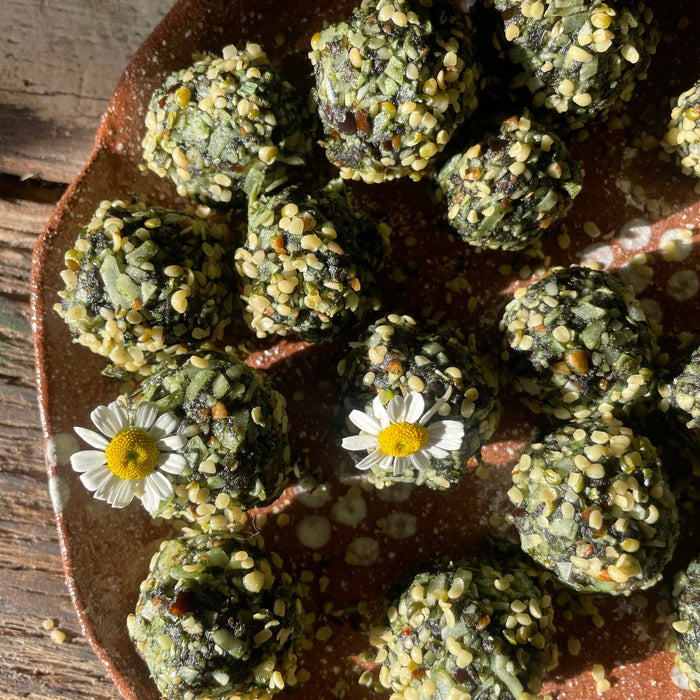Spirulina Energy Balls


This is a topic of much confusion and I will try to simplify it as much as I can. Foods are generally categorised as acid or alkaline based on the residue or ash they leave in the human body after they have been metabolised. It is healthy to strive for a balanced middle ground of alkaline and acid foods.
A variety of health problems can occur when the body is either too alkaline or too acidic. Foods are categorised as either alkaline or acid forming based on their pH values. (The word pH comes from the chemistry formula for calculating the concentration of hydrogen ions present in a substance. pH refers to the power of hydrogen). A pH of 7 is neutral.
Foods with an alkaline ash have pH values above 7. Foods with an acid ash have pH values below 7. Pure water has a neutral pH of 7. However, the correct ratio of acid and alkaline foods in the diet is difficult to know as the balance is altered by chewing (saliva is alkaline), food preparation (cooked food is considered to be more alkaline than raw food), exercise (alkaline) and lifestyle (mostly acid forming if you are stressed) and even our level of positive thinking (toxic thoughts can contribute to more acidity in the body).
Foods such as orange juice and lemon juice are acidic in their natural state but turn alkaline after they have been metabolised in the body. As such, for dietary purposes they are usually considered to be alkaline forming foods despite being acidic prior to consumption.
Generally we are aiming for balance but Paul Pitchford in Healing With Whole Foods says the body should be slightly alkaline in order to build an alkaline reserve for acid-forming conditions such as stress, lack of exercise or poor dietary habits.
Other sources say a proper pH balance and an alkaline rich diet are absolutely necessary for good health. Many diseases are the result of a digestive pH imbalance, in the first stage of digestion, specifically the pH balance in the stomach. In our western culture with an over supply of grains and meat, most people tend towards an overly acidic system.
This can lead to many different ailments including arthritis, osteoporosis, allergies, skin conditions, asthma and even cancer which thrives in an acid environment. So lets look at what foods and other circumstances are acid and what are alkaline. This is based on a few different sources of research and there may be discrepancies with some acid/alkaline charts because of the factors that will affect the acid/alkaline balance.
The acid and alkaline balance can be changed dramatically, according to Paul Pitchford, by simple practices, including soaking mildly acid forming foods such as whole grains and legumes before cooking them and chewing your food thoroughly as this mixes it with saliva which is very alkaline.
He, and many other health practitioners recommend taking a teaspoon of apple cider vinegar at the beginning of each meal to help balance the acid/alkaline level in the intestines and to stimulate gastric secretions thereby aiding digestion. However, it is generally not a good idea to assume your diet is too acidic just because that is a common problem in the general population.
There are many factors that can influence the human body's pH levels. People who drink a lot of mineral water, take mineral supplements or eat a lot of alkaline foods such as dandelion greens or potatoes, may have alkaline levels that are too high. If you want to know exactly where your system is at, you can buy a special type of pH paper that can be used to test pH levels based on urine or saliva samples.
Common sense prevails as always, so eating a wide variety of healthy foods with lots of organic veggies and fruits and smaller amounts of carbohydrate as in brown rice, oats, quinoa, buckwheat etc. and protein from fish, nuts and legumes will help to keep you in good balance. Add to this positive thinking, relaxation, meditation and exercise and you will be a guru of the middle path!
Suzanne Staples, Naturopath, ND DBM ATMS Email: info@heartandspirit.com.au